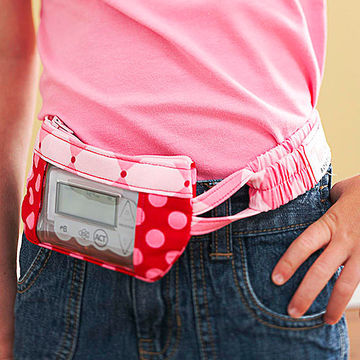“Diabetes is one of the most common chronic diseases in children after asthma, but the percentage of kids who have it is still relatively low,” says Parents advisor Lori Laffel, MD, chief of the pediatric, adolescent, and young-adult section at Harvard’s Joslin Diabetes Center. Here are five important truths about this serious illness.
Fact: Most Children Who Get Diabetes Aren’t Fat

Type 2 diabetes, which is usually triggered by obesity, has gotten a lot of press because it used to strike only adults and is now being diagnosed in kids as young as 6, says Dr. Laffel. Alarming as that is, a greater number of kids get type 1, an autoimmune disease that’s been rising 4 percent a year since the 1970s — especially in young kids. Only 3,700 children are diagnosed with type 2 every year compared with 15,000 who develop type 1, according to a large study that provides the first detailed look at diabetes in U.S. kids.
In many ways, the two forms of diabetes are very different. In type 1, which has no known cause, the immune system mistakenly destroys healthy cells in the pancreas that produce insulin, the hormone that helps the body get energy from food. To make up for the shortfall, children typically need injections of insulin several times a day. In type 2, the pancreas usually makes plenty of insulin (at least at first), but cells throughout the body have trouble using it — a condition known as insulin resistance. But no matter what the type, diabetes causes high blood-sugar levels when glucose from food — the body’s equivalent of gasoline for a car — builds up because it can’t get into cells without insulin. Over time, excess blood sugar can damage organs and tissues throughout the body.
Fact: White Children Are at the Highest Risk
Many people have heard that diabetes is more of a threat to minorities, but about 71 percent of all children who have the disease are white, estimate researchers in the landmark SEARCH for Diabetes in Youth Study. “Type 1 diabetes, which is far more common than type 2, occurs at higher rates in whites,” says Dana Dabelea, MD, PhD, associate professor of medicine in the department of preventive medicine and biometrics at the University of Colorado Denver Health Sciences Center. Although type 2 does occur more frequently in minorities — including African-Americans and Hispanics — their overall risk of getting diabetes is much lower.
Fact: Diabetes Isn’t Caused by Eating Too Much Sugar
While type 2 is typically related to being overweight, sugar has no greater impact on glucose levels in the blood than other types of carbohydrates like rice and potatoes. Doctors are concerned about sugar mainly because it’s found in fattening foods like cookies and ice cream that children love. “Children who are at high risk of type 2 diabetes don’t simply eat too much sugar, they eat too much of everything,” says Dr. Dabelea. Kids who already have diabetes need to limit sweets and simple carbs in order to keep their blood sugar in line, but even a child with type 1 diabetes can eat a brownie every now and then as long as she takes extra insulin to help her body process the sugar, says M. Jennifer Abuzzahab, MD, an endocrinologist at Children’s Hospitals and Clinics of Minnesota, in St. Paul.
Fact: Kids with Diabetes Won’t Necessarily Need Insulin Shots
Many children who have type 2 diabetes can get their blood sugar levels under control just by eating better, losing weight, and exercising regularly, which can help insulin work more effectively. If these lifestyle changes aren’t enough, they can also take oral medications like metformin. But even kids who need to take insulin — all children with type 1 and half of those with type 2 — don’t need to face shots every day. “About half the kids in our clinic use a pump,” says Dr. Abuzzahab. This pager-like device, which is clipped to a waistband or strapped to the torso, is programmed to administer a steady trickle of insulin through a port in the skin. After a meal or snack, when rising blood-sugar levels create demand for more insulin, a child can get an extra dose by just pushing a button.
Fact: Even If a Child with Diabetes Feels Healthy, She’s Still at Risk for Serious Complications
Keeping blood-sugar levels normal throughout life is the key to preventing a variety of problems. Left uncorrected, diabetes can lead to heart attack, cirrhosis of the liver, blindness, amputation of limbs affected by poor circulation, and kidney failure that requires lifelong dialysis. Fortunately, there’s time to prevent these dire conditions while children are still young: It takes about five to 10 years for poorly controlled blood sugar to produce any major complications, according to experts. Serious complications are not inevitable, says Dr. Abuzzahab. “They’re all related to poor blood-sugar control, and most kids can decrease their risk with the right treatment.”
Could Environment Be a Factor in Childhood Diabetes?
Rates of type 1 diabetes have been steadily climbing worldwide. “While early adolescence is still the most common age of onset, some children are being diagnosed even before their first birthday,” says Dr. Laffel. Although kids who develop type 1 are thought to have some sort of genetic predisposition to a malfunctioning immune system, most don’t have a close relative with the condition. The reason for the rise is a mystery, but researchers are looking into three environmental factors.
Extreme Cleanliness Thanks to improved hygiene, children don’t encounter as many germs today, which may interfere with normal development of the immune system.
Weight Gain In kids whose insulin-producing cells have already started malfunctioning, excess weight may accelerate the development of full-blown diabetes.
Early Solids Feeding cereal before 3 months to a baby who is at higher risk for type 1 may be linked to triggering the immune system to mistakenly attack his pancreas.
3 Diabetes Symptoms
The onset of type 1 is sudden, and type 2 is slow. Either way, it’s easy for parents to miss these classic symptoms.
Bedwetting, accidents, or saturated diapers. As your child’s body tries to flush out excess blood sugar, there’s an increase in the volume of urine.
Unquenchable thirst. This loss of excreted fluid makes the body crave replenishment.
Dehydration. Dry mouth, lack of tears, and sunken eyes are also signs your child’s body doesn’t have enough fluid.





